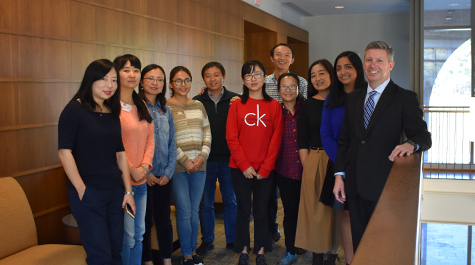An exchange of ideas on excellence in university teaching
Nine faculty from William & Mary’s sister university, the University of Electronic Science and Technology of China (UESTC), in Chengdu, China, are spending the fall semester studying the pedagogical approaches of W&M faculty as part of the inaugural cohort of the Excellence in University Teaching Program.
The visiting faculty hail from a range of disciplines including law, economics, physics, languages, humanities, and leadership. The program is co-hosted by the School of Education and the Reves Center for International Studies.
The novel program already is yielding unexpected benefits for all involved.
“What originated as a professional development program for a group of professors from a sister university has really developed into a deepening of the relationship between the two universities,” observed Stephen J. Sechrist, director of the Office of International Students Scholars and Programs at the Reves Center.
Sechrist has facilitated the program throughout, and helped connect the visiting faculty with W&M faculty in their field who are serving as collegial peers on campus.
“It’s a bilateral opportunity for an exchange of ideas between our faculties on the subjects of university pedagogy, course design, how we motivate and assess students and how we engage them,” he said.
Each week, the visiting faculty attend a teaching workshop with program co-directors James Barber, associate professor of education, and Katherine Barko-Alva, assistant professor of ESL/bilingual education, in addition to observing courses taught in their discipline. They also take English language classes taught by Wendy Waldeck, an instructor in the English Language Program at the Reves Center. Sechrist noted that the English language instruction is designed specifically to enhance the Chinese faculty members’ abilities to conduct classes and academic presentations in English, which is the lingua franca of international conferences.
The faculty from UESTC also have experienced some serendipitous pedagogical opportunities, such as observing a dissertation defense and attending guest lectures and symposia in their fields.
Barko-Alva and Barber reported that faculty from both institutions are exploring the cultural differences, even as they also discuss the differences in teaching styles between disciplines as a whole. The pair also have observed differences in perceptions of academic freedom and access to resources between higher education in China and the United States.
“The beauty of it is that during seminars we have the opportunity to learn from each other and question each other in terms of pedagogical practices, which faculty don’t ordinarily get to do. It’s a powerful experience for them and us,” said Barko-Alva, adding that at any given moment conversations may be conducted in either Mandarin or English, or both, in their seminar.
Barber and Barko-Alva are gathering data about the experiences of the UESTC faculty through surveys and a narrative analysis of the participants’ written reflections. “There’s a research component to this program,” they explained. “We are really interested in faculty development, not just cross-culturally but across languages as well.”
The structure of the program “allows us to be responsive to the needs of the faculty members,” said Barber. “What we discuss in our seminar may change depending on what they observe in their classes and what is going on on-campus.”
The semester is a complete immersion experience for the visiting faculty. They rent apartments or houses in the local Williamsburg and James City County community and those with school age children have enrolled them in local schools.
“I think it is a very brave undertaking to leave what you know and be open to new ways of learning,” said Barko-Alva.
The UESTC faculty members’ semester long study here is funded by their home university. The program will continue for two years, with four cohorts of faculty spending a semester here absorbing the William & Mary approach to pedagogical excellence.
Sechrist noted that the program is building the dynamic relationship between the two institutions, leading to joint research proposals and discussions about W&M faculty guest lecturing at UESTC in the future.
 Skip to main content
Skip to main content

